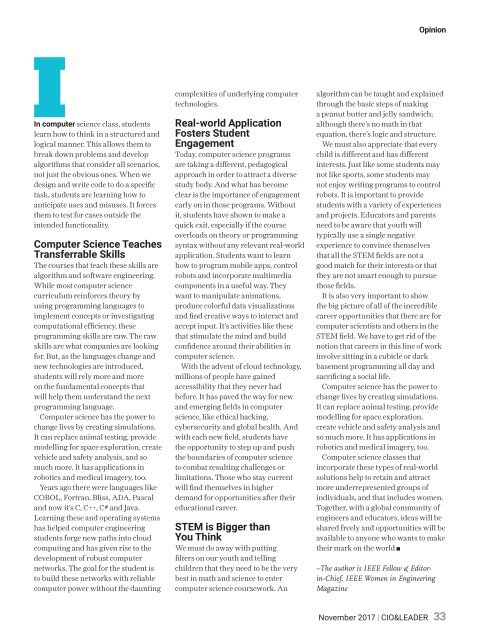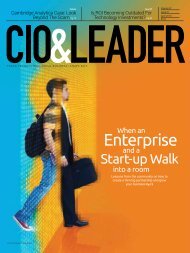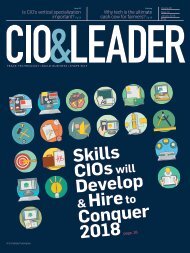CIO & LEADER-November 2017 (1)
You also want an ePaper? Increase the reach of your titles
YUMPU automatically turns print PDFs into web optimized ePapers that Google loves.
Opinion<br />
IIn<br />
computer science class, students<br />
learn how to think in a structured and<br />
logical manner. This allows them to<br />
break down problems and develop<br />
algorithms that consider all scenarios,<br />
not just the obvious ones. When we<br />
design and write code to do a specific<br />
task, students are learning how to<br />
anticipate uses and misuses. It forces<br />
them to test for cases outside the<br />
intended functionality.<br />
Computer Science Teaches<br />
Transferrable Skills<br />
The courses that teach these skills are<br />
algorithm and software engineering.<br />
While most computer science<br />
curriculum reinforces theory by<br />
using programming languages to<br />
implement concepts or investigating<br />
computational efficiency, these<br />
programming skills are raw. The raw<br />
skills are what companies are looking<br />
for. But, as the languages change and<br />
new technologies are introduced,<br />
students will rely more and more<br />
on the fundamental concepts that<br />
will help them understand the next<br />
programming language.<br />
Computer science has the power to<br />
change lives by creating simulations.<br />
It can replace animal testing, provide<br />
modelling for space exploration, create<br />
vehicle and safety analysis, and so<br />
much more. It has applications in<br />
robotics and medical imagery, too.<br />
Years ago there were languages like<br />
COBOL, Fortran, Bliss, ADA, Pascal<br />
and now it’s C, C++, C# and Java.<br />
Learning these and operating systems<br />
has helped computer engineering<br />
students forge new paths into cloud<br />
computing and has given rise to the<br />
development of robust computer<br />
networks. The goal for the student is<br />
to build these networks with reliable<br />
computer power without the daunting<br />
complexities of underlying computer<br />
technologies.<br />
Real-world Application<br />
Fosters Student<br />
Engagement<br />
Today, computer science programs<br />
are taking a different, pedagogical<br />
approach in order to attract a diverse<br />
study body. And what has become<br />
clear is the importance of engagement<br />
early on in those programs. Without<br />
it, students have shown to make a<br />
quick exit, especially if the course<br />
overloads on theory or programming<br />
syntax without any relevant real-world<br />
application. Students want to learn<br />
how to program mobile apps, control<br />
robots and incorporate multimedia<br />
components in a useful way. They<br />
want to manipulate animations,<br />
produce colorful data visualizations<br />
and find creative ways to interact and<br />
accept input. It’s activities like these<br />
that stimulate the mind and build<br />
confidence around their abilities in<br />
computer science.<br />
With the advent of cloud technology,<br />
millions of people have gained<br />
accessibility that they never had<br />
before. It has paved the way for new<br />
and emerging fields in computer<br />
science, like ethical hacking,<br />
cybersecurity and global health. And<br />
with each new field, students have<br />
the opportunity to step up and push<br />
the boundaries of computer science<br />
to combat resulting challenges or<br />
limitations. Those who stay current<br />
will find themselves in higher<br />
demand for opportunities after their<br />
educational career.<br />
STEM is Bigger than<br />
You Think<br />
We must do away with putting<br />
filters on our youth and telling<br />
children that they need to be the very<br />
best in math and science to enter<br />
computer science coursework. An<br />
algorithm can be taught and explained<br />
through the basic steps of making<br />
a peanut butter and jelly sandwich;<br />
although there’s no math in that<br />
equation, there’s logic and structure.<br />
We must also appreciate that every<br />
child is different and has different<br />
interests. Just like some students may<br />
not like sports, some students may<br />
not enjoy writing programs to control<br />
robots. It is important to provide<br />
students with a variety of experiences<br />
and projects. Educators and parents<br />
need to be aware that youth will<br />
typically use a single negative<br />
experience to convince themselves<br />
that all the STEM fields are not a<br />
good match for their interests or that<br />
they are not smart enough to pursue<br />
those fields.<br />
It is also very important to show<br />
the big picture of all of the incredible<br />
career opportunities that there are for<br />
computer scientists and others in the<br />
STEM field. We have to get rid of the<br />
notion that careers in this line of work<br />
involve sitting in a cubicle or dark<br />
basement programming all day and<br />
sacrificing a social life.<br />
Computer science has the power to<br />
change lives by creating simulations.<br />
It can replace animal testing, provide<br />
modelling for space exploration,<br />
create vehicle and safety analysis and<br />
so much more. It has applications in<br />
robotics and medical imagery, too.<br />
Computer science classes that<br />
incorporate these types of real-world<br />
solutions help to retain and attract<br />
more underrepresented groups of<br />
individuals, and that includes women.<br />
Together, with a global community of<br />
engineers and educators, ideas will be<br />
shared freely and opportunities will be<br />
available to anyone who wants to make<br />
their mark on the world<br />
–The author is IEEE Fellow & Editorin-Chief,<br />
IEEE Women in Engineering<br />
Magazine<br />
<strong>November</strong> <strong>2017</strong> | <strong>CIO</strong>&<strong>LEADER</strong><br />
33














